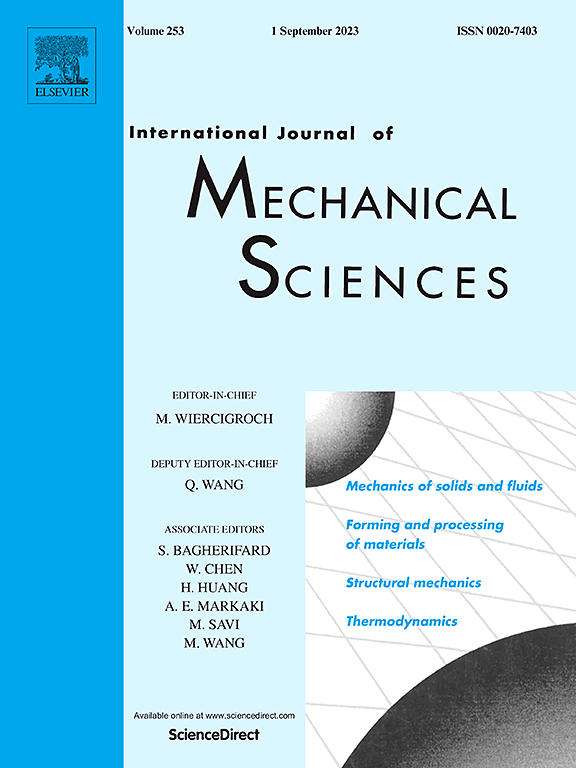Enhancing piezoelectric energy harvesters with rotating triangular auxetic structures
IF 7.1
1区 工程技术
Q1 ENGINEERING, MECHANICAL
International Journal of Mechanical Sciences
Pub Date : 2025-02-18
DOI:10.1016/j.ijmecsci.2025.110081
引用次数: 0
Abstract
The development of piezoelectric energy harvesters is currently constrained by factors such as output power, bandwidth, and natural frequency, which limit their capacity to efficiently capture the low-frequency vibrational energy prevalent in the environment. To address these challenges, this paper proposes a novel approach to enhance the performance of piezoelectric energy harvesters by integrating a rotating triangular auxetic structure. A method for analyzing the mechanical performance of the auxetic structure under lateral constraints is introduced, demonstrating that the structure exhibits favorable negative Poisson's ratio characteristics and design flexibility. Furthermore, the auxetic structure is incorporated into a cantilever beam piezoelectric energy harvester to design and fabricate a novel auxetic-enhanced energy harvester (AEH), alongside a plate substrate energy harvester (PEH) for comparison. Finite element method (FEM) simulations and experimental results show that the auxetic structure increases the average stress in the piezoelectric patch, creating a distinct negative Poisson's ratio region. Under varying geometric parameters and unit cell numbers, the proposed AEH outperforms the conventional PEH, with output power improvements ranging from 96.3 % to 266.1 %, and reductions in natural frequency between 15.35 % and 42.65 %. By appropriately selecting geometric parameters, the AEH also broadens the energy harvesting bandwidth. This enhancement makes the AEH particularly well-suited for capturing low-frequency vibrational energy from the environment. The large negative Poisson's ratio of the auxetic structure, as demonstrated in this study, contributes to an increased energy density in the piezoelectric patch.

求助全文
约1分钟内获得全文
求助全文
来源期刊

International Journal of Mechanical Sciences
工程技术-工程:机械
CiteScore
12.80
自引率
17.80%
发文量
769
审稿时长
19 days
期刊介绍:
The International Journal of Mechanical Sciences (IJMS) serves as a global platform for the publication and dissemination of original research that contributes to a deeper scientific understanding of the fundamental disciplines within mechanical, civil, and material engineering.
The primary focus of IJMS is to showcase innovative and ground-breaking work that utilizes analytical and computational modeling techniques, such as Finite Element Method (FEM), Boundary Element Method (BEM), and mesh-free methods, among others. These modeling methods are applied to diverse fields including rigid-body mechanics (e.g., dynamics, vibration, stability), structural mechanics, metal forming, advanced materials (e.g., metals, composites, cellular, smart) behavior and applications, impact mechanics, strain localization, and other nonlinear effects (e.g., large deflections, plasticity, fracture).
Additionally, IJMS covers the realms of fluid mechanics (both external and internal flows), tribology, thermodynamics, and materials processing. These subjects collectively form the core of the journal's content.
In summary, IJMS provides a prestigious platform for researchers to present their original contributions, shedding light on analytical and computational modeling methods in various areas of mechanical engineering, as well as exploring the behavior and application of advanced materials, fluid mechanics, thermodynamics, and materials processing.
 求助内容:
求助内容: 应助结果提醒方式:
应助结果提醒方式:


